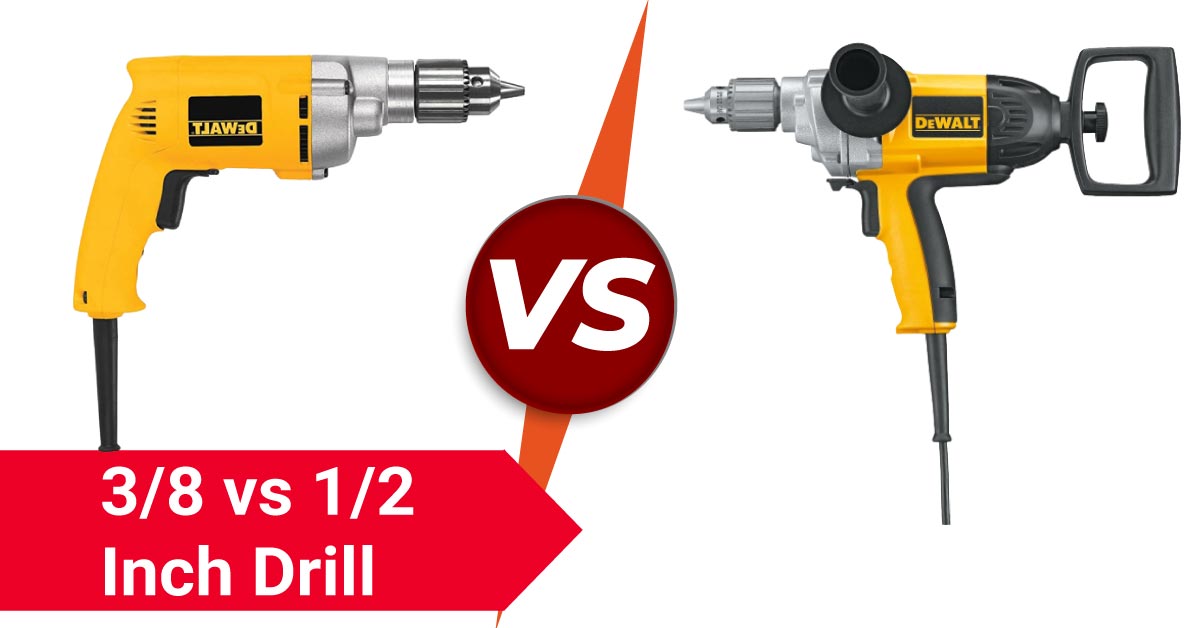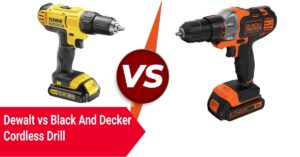Drills are among the most important tools in any DIY enthusiast’s arsenal. However, with so many different types and sizes available on the market, deciding which one to choose for your specific needs can take time and effort. In this article, we’ll look at the differences between 3/8 vs 1/2 inch drills and which is best for which jobs.
3/8 Vs 1/2 Inch Drills?
3/8 inch drills are smaller and lighter than their 1/2 inch counterparts. They are usually less powerful and have less torque, which makes them ideal for more delicate tasks like drilling holes in wood or metal. They are also more versatile and can be used for various tasks.
On the other hand, 1/2 inch drills are larger and more powerful. They have more torque and can quickly drill through more rigid materials like concrete or masonry. They are ideal for heavy-duty tasks and frequently found on construction sites or professional projects.
Understanding these distinctions can help you choose the best drill for your needs and preferences.
Size and Weight
The size and weight of a 3/8 inch drill and a 1/2 inch drill are two of the most noticeable differences. 3/8 inch drills are generally smaller and lighter than 1/2 inch drills, making them easier to handle and maneuver. This can be useful when working in confined spaces or drilling overhead. However, 1/2 inch drills are more powerful and can work with larger, more rigid materials.
Power
Another significant distinction between a 3/8 inch drill and a 1/2 inch drill is their power. 1/2 inch drills are typically more powerful and can work with more difficult materials such as concrete or masonry. They can also provide more force to the drill bit because they have higher torque. This can be advantageous when working on heavy-duty tasks or drilling through hard materials.
Speed
In addition to power, 1/2 inch drills have a faster speed than 3/8 inch drills. This means they can drill faster and more efficiently, which can be useful when working on large projects or when time is of the essence. Higher speeds, on the other hand, can cause more wear and tear on the drill bit and necessitate more frequent bit changes.
Versatility
3/8 inch drills are more versatile than 1/2 inch drills. They can work with a broader range of materials and tasks, from drilling small holes in wood or metal to installing screws or bolts. They are also easier to handle and maneuver, which can be useful in tight spaces or when working at awkward angles. 1/2 inch drills, on the other hand, are more specialized and better suited for heavy-duty tasks like drilling through concrete or masonry.
Cost
Another factor to consider when deciding between a 3/8 vs 1/2 inch drill is price. 3/8 inch drills are typically less expensive than 1/2 inch drills, making them a more cost-effective option for those on a tight budget. However, the cost of a drill will also be determined by the drill’s specific features and capabilities, as well as the brand and quality of the tool.
Factors to Consider When Choosing Between 3/8 and 1/2 inch Drills
There are several factors to consider when deciding between a 3/8 inch drill and a 1/2 inch drill. The drill you choose will be determined by the type of job you will be performing, the material you will be drilling into, your level of experience, and your personal preferences.
One of the most important factors to consider is the type of job you will be doing. A 3/8 inch drill may suffice for light-duty tasks such as drilling holes in wood or metal. A 1/2 inch drill, on the other hand, may be required for heavy-duty tasks such as drilling through concrete or masonry.
Another thing to think about is the material you’ll be drilling into. A 3/8 inch drill may be more appropriate for drilling into softer materials like wood or plastic. A 1/2 inch drill, on the other hand, may be required if you are drilling into harder materials such as metal or concrete.
Your level of experience is also an important factor to consider. If you are a beginner or have limited experience with power tools, a 3/8 inch drill may be easier to handle and less intimidating. If you are more experienced and comfortable with power tools, a 1/2 inch drill may be more suitable for your needs.
Finally, when deciding between a 3/8 inch drill and a 1/2 inch drill, personal preference should be taken into account. Some people prefer the lighter weight and versatility of a 3/8 inch drill, while others prefer the power and speed of a 1/2 inch drill.
In addition to these considerations, the drill’s features must be considered. Choose a drill with variable speed control, a keyless chuck for quick bit changes, and a comfortable grip to reduce hand fatigue. You should also consider whether you need a corded or cordless drill based on your specific needs and preferences.
Best 3/8 inch Drills
If you’ve decided that a 3/8 inch drill is the best option for your needs, there are several top-rated models on the market. The following are some of the best 3/8 inch drills:
DEWALT DCD771C2 20V MAX Cordless Drill
This cordless drill is a popular choice among DIY enthusiasts and professionals alike. It has a 20-volt battery and can deliver up to 300 unit watts out (UWO) of power. It also has two speed settings and a lightweight design, making it easy to handle and control.
Makita XFD131 18V LXT Cordless Drill
This drill has a powerful 18-volt battery and can deliver up to 440 pounds of torque. It also has a compact and ergonomic design, making it comfortable to use for extended periods of time. Additionally, it comes with a built-in LED light to illuminate your work area.
BLACK+DECKER LDX120C Cordless Drill
This cordless drill is affordable and lightweight, making it a great option for beginners. It has a 20-volt battery and can deliver up to 650 RPM of speed. It also has an 11-position clutch and a built-in LED light.
Best 1/2 inch Drills
If you’ve decided that a 1/2 inch drill is the best option for your needs, there are several high-rated models on the market. The following are some of the best 1/2 inch drills:
DEWALT DCD771C2 20V MAX Cordless Drill
This cordless drill is also an excellent choice for those who require a 1/2 inch drill. It has a 20-volt battery and a power output of up to 300 UWO. It also has a fast transmission, making it ideal for heavy-duty applications.
Bosch 11255
Bosch 11255VSR Bulldog Xtreme 1-Inch SDS-plus Rotary Hammer:
This rotary hammer drill is a powerful tool that can easily handle heavy-duty tasks. It has a 7.5-amp motor and can deliver up to 1,300 RPM of speed. It can also operate in three modes: rotary hammer, hammer only, and rotation only.
Makita XPH07Z 18V LXT Lithium-Ion Brushless Cordless 1/2-Inch Hammer Driver-Drill:
This cordless hammer drill has an 18-volt battery that produces up to 1,090 pounds of torque. It also has a brushless motor, which provides longer battery life as well as increased power and speed.
Conclusion
The type of material being drilled, the type of job being performed, the user’s experience level, and personal preference all play a role in deciding a 3/8 vs 1/2 inch drill. 3/8 inch drills are lighter and more versatile than 1/4 inch drills, making them ideal for lighter tasks like drilling holes in wood or metal. 1/2 inch drills, on the other hand, are larger and more powerful, making them ideal for heavy-duty tasks like drilling through concrete or masonry.
When selecting a drill, it is critical to consider the job and select a drill with sufficient power and torque to complete the task efficiently. Both 3/8 and 1/2 inch drills have advantages and disadvantages that must be considered when making a decision.
Finally, the best drill for you is determined by your unique needs and preferences. Using the factors discussed in this article, you can select the best drill for your project and complete it quickly and efficiently.




